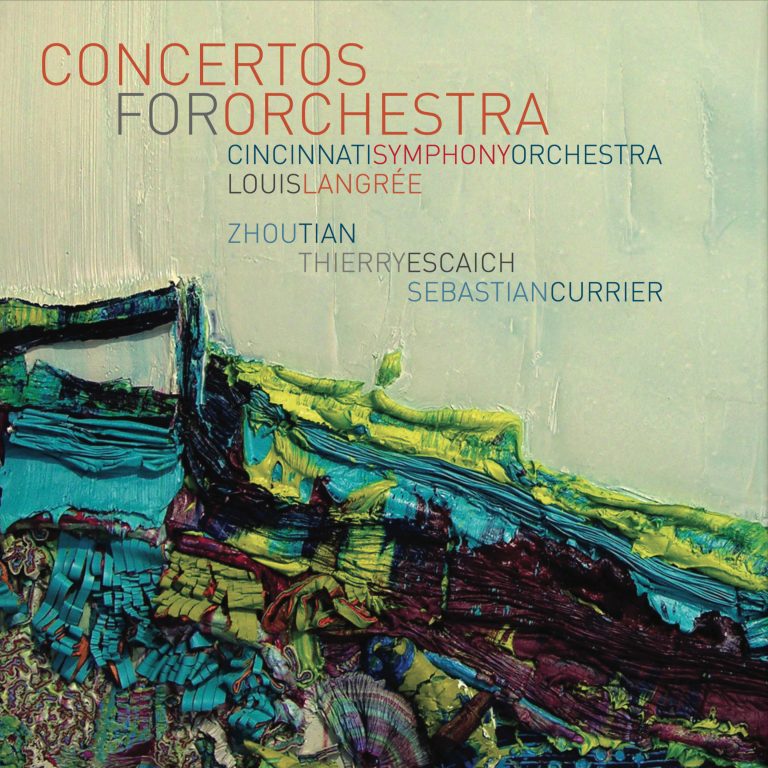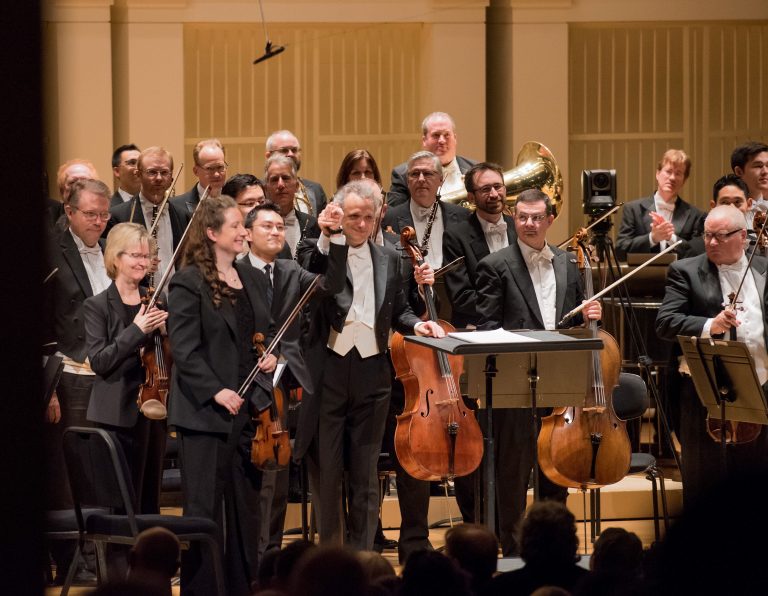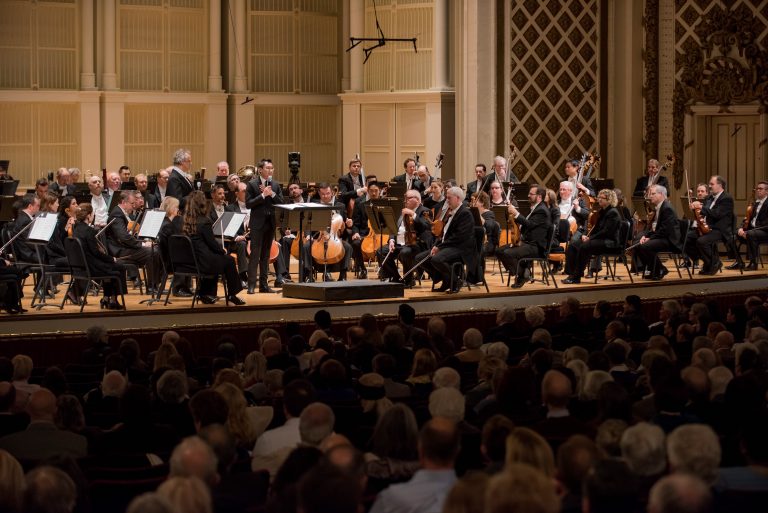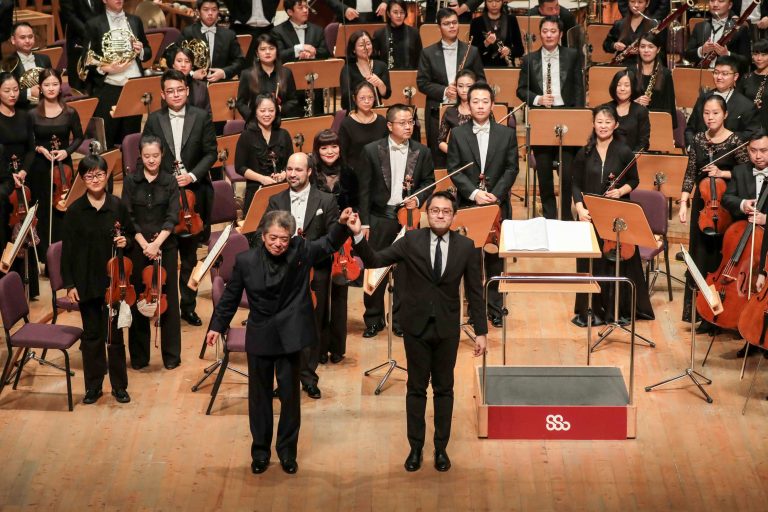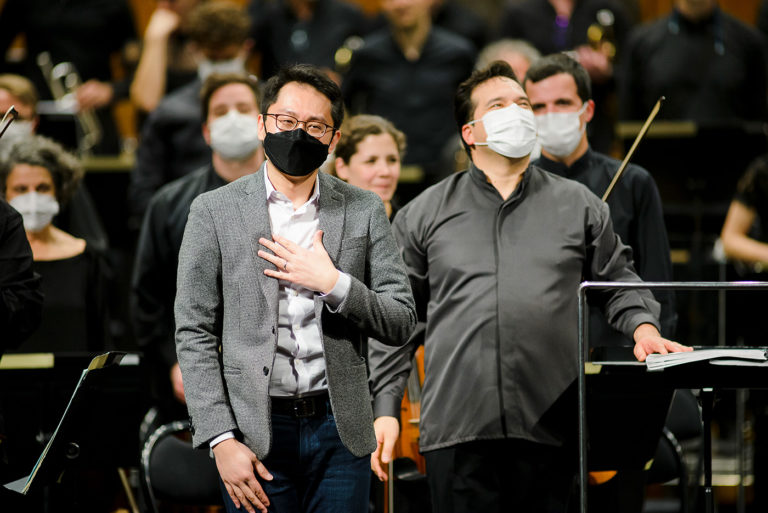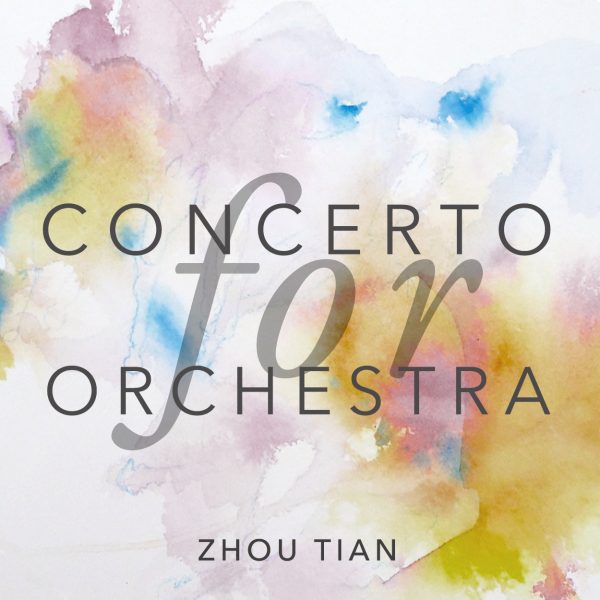
Concerto for Orchestra
(2016) | 35 minutes
Commissioned by the Cincinnati Symphony
SCORING 3(alto,picc) . 3(corA) . 3(Bs.Cl) . 3(cbn) / 4331 / timp / 3 perc: glockenspiel, xylophone, crotale (bowed),vibraphone, chimes, snare drum, cymbals (suspended, crash), tamtam, low tuned gongs, bass drum / hp / pno(cel.) / str
PREMIERE 13-14 May 2016, Music Hall, Cincinnati, OH. The Cincinnati Symphony Orchestra conducted by Louis Langrée
RECORDING The Cincinnati Symphony conducted by Louis Langrée. Fanfare Cincinnati (NAXOS)
Snapshot
My Concerto for Orchestra is a love letter to the symphony orchestra, featuring passages that range from epic to intimate. It is scored lushly through four parts: “Glow,” a journey to splendor through two contrasting themes; “Indigo,” a musical postcard from a walk in the forest one late summer night; “Seeker’s Scherzo,” a retro miniature; and “Intermezzo – Allegro,” a fierce rhapsody that begins with a lyrical fugue. Beneath the power and edginess, there is an unmistakable sense of romanticism in the music. —Zhou Tian
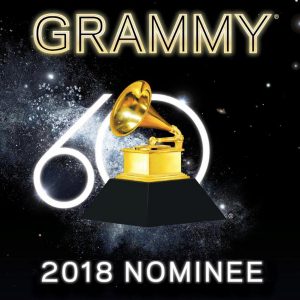
Nominee, 60th Grammy Award for Best Contemporary Classical Composition
“Stunning…tonal and engaging, it was an ambitious showpiece in four symphonic movements.”
—The Cincinnati Enquirer
“He is unafraid of monumental gestures, but at the same time he wastes nothing, whether notes or our time itself.” “There are always touches of fine craftsmanship. The strings’ luster made me wish I could stop writing and just listen.”
—American Record Guide
“…Ravishing, its second movement a gorgeous, impressionistic wallow.”
—The Arts Desk (London)
Listen
I. Glow (0:00)
II. Indigo (13:24)
III. Seeker’s Scherzo (23:11)
IV. Intermezzo – Allegro (26:30)
Promo short for the San Francisco Symphony
Promo short for the Toronto Symphony
Promo short for the Shanghai Symphony
Programme Note
My Concerto for Orchestra is a love letter to the symphony orchestra, featuring passages that range from epic to extremely intimate. It is scored lushly and mostly tonally, and nearly every instrument is treated soloistically. Beneath the power and edginess, there is an unmistakable sense of romanticism in the music.
The 35-minute work contains four movements. It opens with “Glow,” a journey to splendor through two contrasting themes. Just when you think the music has reached a climactic point, a more expansive and emotional moment awaits around the corner. Keen listeners may discover hidden homages to some of the great concerti for orchestra from the past.
“Indigo,” a meditative second movement, is a musical postcard from a walk in the forest one late summer night. Plush strings, lyrical oboe solo, dashing flutes and harp, and dark brass paint shades of blue into indigo…
A retro miniature called “Seeker’s Scherzo” follows. It draws inspiration from the classical form while incorporating new turns and twists, constantly exploring different colors and timbre. The finale, “Intermezzo – Allegro,” begins with a lyrical fugue executed in a “build-an-orchestra” fashion: a melody played first by the solo violin is steadily expanded to an entire orchestra, at which point a fierce rhapsody is ignited. Here, occasional touches of jazz syncopation and harmony are mixed with folksy tunes in perpetual motion.
©Zhou Tian
周 天
樂隊協奏曲
I. 暉 光
II. 藍 紗
III. 探索者的諧謔曲
IV. 間奏曲與快板
時⻑:約35分鐘
《樂隊協奏曲》由⾟⾟那提交響樂團和⾳樂總監路易·朗格萊委約,於2016年5⽉13⽇在該樂團2015-2016樂季的閉幕⾳樂會中⾸演。⾃從巴托克1943年創作的同名作品以來,「樂隊協奏曲」這種新的樂曲類型便賦予了讓樂隊中的每個樂⼿或聲部成為獨奏的使命,象徵著管弦樂寫作的⼀種新的極致:絢麗斑斕、收放⾃如,是傳統交響曲在20世紀的重⽣。我的《樂隊協奏曲》在試圖延續這個傳統的同時,融⼊了我個⼈的聲⾳和對於「東⻄⽅⽂化交會」的理解。作品展現了當今管弦樂團無窮的張⼒——從史詩般壯闊到極致的婉約,從中國⺠族⾳調的應⽤到現代和聲與爵⼠節拍的結合。我希望這是⼀個讓演奏者和聽眾都能傾情投⼊的⾳樂旅程。它既展現了現代作品強烈的衝擊⼒,也瀰漫著浪漫主義情調。可以說,它是我作為作曲者獻給管弦樂團的⼀封⾳樂「情書」。
作品透過《暉光》《藍紗》《探索者的諧謔曲》《間奏曲與快板》四個樂章,展現了四種不同的⾳樂形象,時⽽華麗,時⽽古樸,在創新的同時致敬傳統。©周天
Reviews
Louis Langrée’s program featuring Beethoven’s “Eroica” Symphony and a world premiere by Chinese-born composer Zhou Tian was nothing but celebratory. It was a splendid send-off before the orchestra decamps to a temporary home at the Taft Theatre. Both performances were inspired, and listeners were on their feet twice, with enthusiastic and lengthy ovations.
Zhou Tian’s Concerto for Orchestra was the third installment of Langrée’s Concerto for Orchestra project, and it was being recorded live for a planned album on the orchestra’s label. The 34-year-old composer is among the third generation of Chinese-born composers now impacting American music.
Trained at Philadelphia’s Curtis Institute of Music, New York’s Juilliard School and the University of Southern California, Zhou Tian has studied with some of America’s finest composers, such as Jennifer Higdon. But his music also displays his gift for lyricism and evocative color that may be the result of his Chinese upbringing. The composer told the audience that his concerto was “a love letter” to the CSO. Besides power and “edginess,” he tried to mirror the romantic quality of the orchestra in his music, he said.
Tonal and engaging, it was an ambitious showpiece in four symphonic movements. The first, entitled “Glow,” was a patchwork of many ideas, including glowing instrumental colors, lush melodies for the strings, staccato figures for the trumpets and big cadenza for clarinet (Jonathan Gunn), complete with Gershwin-like “smears.”…the slow movement, “Indigo,” was stunning. Atmospheric and reminiscent of Bartok’s “night music,” it featured bird calls for the flutes and mystical writing for the strings.
A lighthearted scherzo movement followed, with an angular theme that wound its way inventively through a number of orchestral soloists. The finale balanced intimate, chamber-like sections – such as an opening sextet for five strings and clarinet – against romantic melodies for full orchestra. A driving perpetual motion, it continuously engaged the ear with inventive touches such as ripples in the piano, timpani flourishes and Chinese gongs.
Langrée led with conviction, and the musicians gave it a top-notch reading. While Zhou Tian took a bow, the conductor went into the ranks to shake the hand of each orchestral soloist, and there were many.
—The Cincinnati Enquirer
Zhou Tian (Zhou is his family name) was born in China in 1981, and he’s now on the faculty of Colgate University in Hamilton NY. All his teachers–Jennifer Higdon and Christopher Rouse among them–were Americans, and there was nothing in his concerto that sounded overtly Asian. Zhou’s writing, like Escaich’s, is tonally based, but phrases often follow themselves to their own conclusions, whether or not they butt up against another phrase. His harmonies have a Hindemithian punch to them. The first theme in the first movement is playful, with rippling woodwinds and hints of Stravinsky and impressionism. The lower strings introduce the second theme, slower and more romantic. Zhou makes his structures very clear. He is unafraid of monumental gestures, but at the same time he wastes nothing, whether notes or our time itself. A clarinet cadenza seemed out of place until the other winds joined in, reconstructing the opening theme around it for the recapitulation.
In II gauzy strings and then summery winds present themselves; Zhou’s sense of dissonance is almost rigorous, but he writes so smoothly and naturally that they gave no offense. The orchestra played like they’d known the piece all their lives; the musicians were the most united and expressive I’ve heard in a while. The strings’ luster made me wish I could stop writing and just listen. The last two movements are thematically weaker, though there are always touches of fine craftsmanship. In the final movement, Intermezzo-Allegro, the trumpet fanfare that marked the transition between the two parts was brought in with astounding deftness. I only wished the themes lived up to what came before.
My understanding is that all three concertos are coming out on disc at some point, and I’m looking forward to hearing them again. Maybe I’ll hear things in the last two movements that I didn’t the first time through. If it’s not a masterpiece, it is still a work to be proud of.
—American Record Guide
“…Ravishing, its second movement a gorgeous, impressionistic wallow.”
—The Arts Desk (London)
